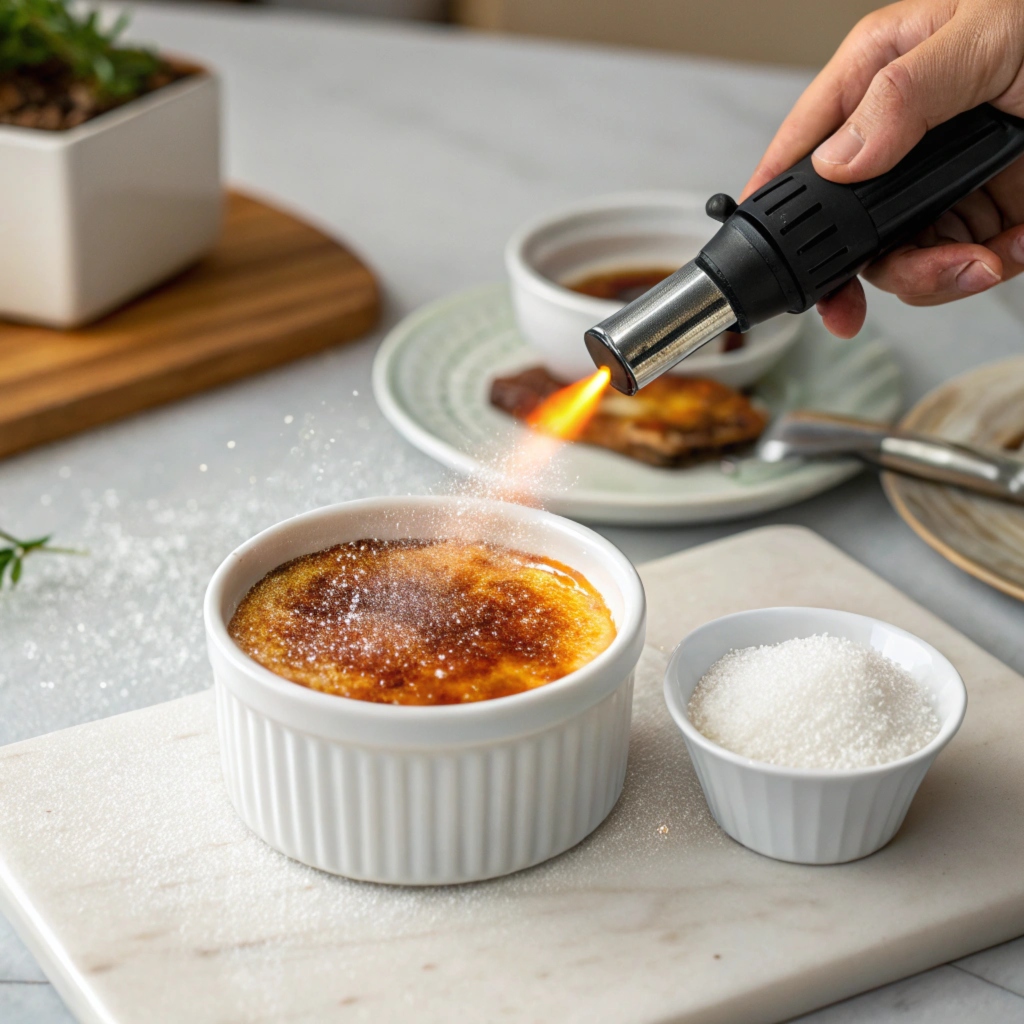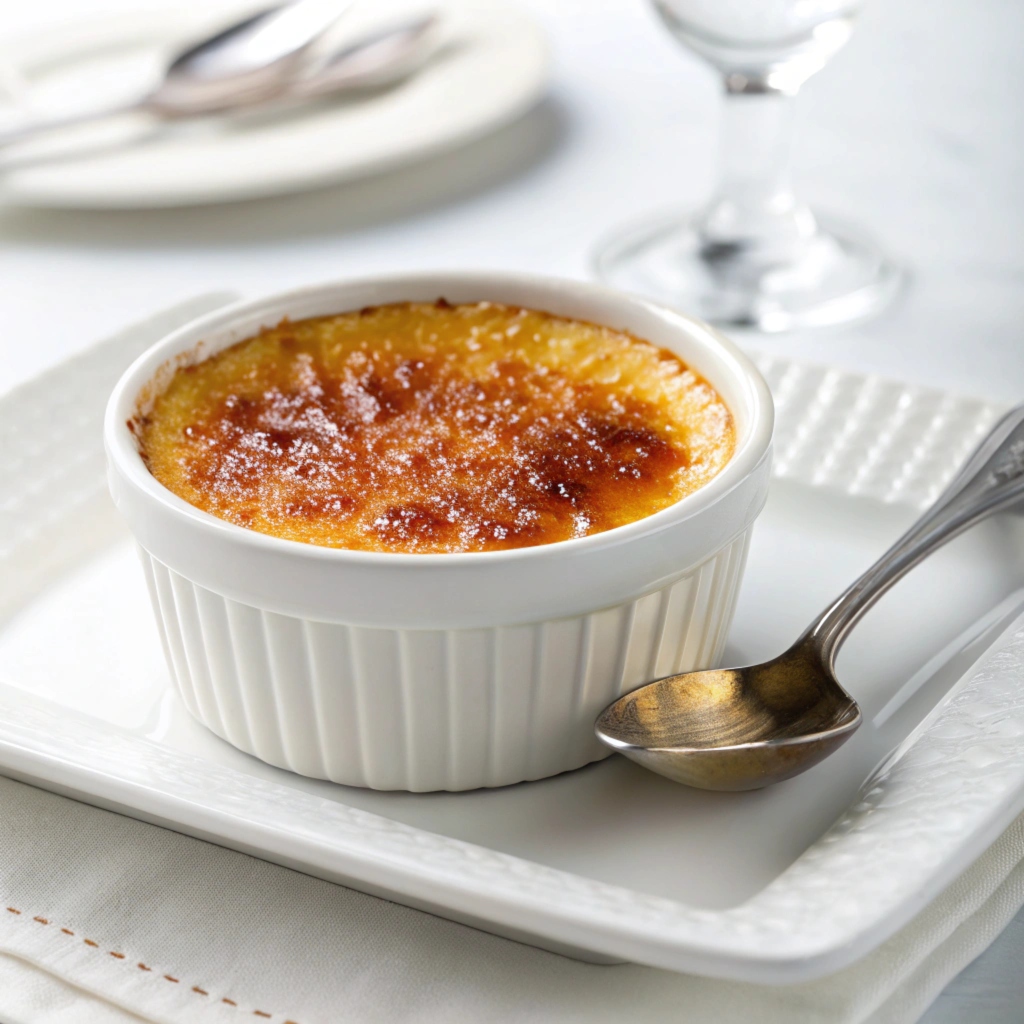Crème brûlée, which translates to “burnt cream” in French, is a rich, velvety dessert made from a smooth custard base topped with a crisp, caramelized sugar crust. Typically served in small, individual ramekins, its most iconic moment comes when the spoon cracks through the hard sugar topping, revealing the creamy, silky custard beneath. This contrast in texture — crunchy on top and smooth below — is part of what makes crème brûlée so irresistible. What is crème brûlée made of?
Crème brûlée is a type of baked custard, but its signature caramelized sugar layer sets it apart from other custards. To create the golden-brown crust, chefs sprinkle sugar on top of the chilled custard and melt it using a kitchen torch or oven broiler, forming a crisp, glass-like shell.
Loved for its elegant simplicity and luxurious texture, crème brûlée is a star dessert in high-end restaurants and a beloved treat in home kitchens. Its balance of creamy richness and crunchy sweetness provides a sensory experience that few desserts can match, making it a timeless classic on dessert menus worldwide.
Table of contents
Origin and History of Crème Brûlée
While many people naturally associate crème brûlée with French cuisine, its true origins remain a topic of debate. In fact, culinary historians trace its roots to three countries: France, Spain, and England. Interestingly, each nation claims credit for inventing the concept of custard with a burnt sugar topping, and each has its own unique version of this iconic dessert.
France: To begin with, the French undeniably gave the dessert its name, “crème brûlée.” Moreover, François Massialot documented the earliest known recipe in his 1691 cookbook. Notably, the French version most closely resembles what we know today, with its silky custard and torched sugar topping. Because of this, France is often credited as the birthplace of the modern crème brûlée enjoyed worldwide.
Spain: On the other hand, Spain’s version, known as “Crema Catalana”, predates the French version. Unlike crème brûlée, Crema Catalana features distinct flavors like lemon or cinnamon and uses milk instead of cream.As a result, people often view Crema Catalana as a lighter, more citrusy alternative. Due to these differences, many culinary experts argue that Crema Catalana deserves its own unique recognition, rather than seeing it solely as a precursor to crème brûlée.
England: Meanwhile, in England, the dessert goes by the name “Trinity Cream”, a dish famously served at Trinity College, Cambridge. According to culinary records, chefs at the college first made it in the 17th century, where they used a hot iron to burn the sugar topping. Because of this technique, Trinity Cream established its own distinct identity as a similar yet separate dessert. Even today, the tradition of serving Trinity Cream at the college continues, showcasing its historical importance in British culinary heritage.
Why Do People Love Crème Brûlée?
Crème brûlée isn’t just loved for its taste — it’s the overall experience of eating it that makes it unforgettable. Here are some reasons why people can’t get enough of this classic dessert:
- The Texture Contrast: There’s nothing quite like the experience of tapping the hard sugar crust with a spoon and hearing that satisfying crack. Beneath the brittle caramelized sugar lies a creamy, smooth custard that melts in your mouth.
- The Flavor Balance: The balance of sweetness, creaminess, and the slight bitterness from the burnt sugar is a sensory delight. This mix of rich custard and crispy caramel provides both comfort and elegance in every bite.
- The Visual Appeal: Crème brûlée is a visually stunning dessert. The golden, glass-like sugar crust glistens under the light, while the smooth, pale custard below creates a striking contrast. Its elegance makes it a popular choice in fine-dining establishments.
- The Simplicity of Ingredients: Despite its luxurious appearance, crème brûlée is made with just four essential ingredients. This simplicity, combined with its complexity of taste, makes it a culinary marvel.
The Essential Ingredients of Crème Brûlée

Crème brûlée’s magic lies in its simple, yet essential ingredients. The classic recipe uses just four key components that create its rich, creamy base and crispy caramel crust. Here’s a look at the essential ingredients and their roles.
1. Cream (The Heart of the Custard)
Heavy cream is the foundation of crème brûlée’s smooth, velvety texture. Its high fat content (30-35%) gives the custard its signature thickness and richness.
- Why It’s Essential: The fat in cream creates the silky, indulgent texture that defines crème brûlée.
- Type of Cream: Heavy cream or whipping cream works best. Using low-fat milk results in a thinner, less creamy texture.
- Substitutes: Coconut cream can be used for a dairy-free option, but it adds a coconut flavor.
2. Egg Yolks (The Silky Binder)
Egg yolks thicken the custard, binding the cream, sugar, and vanilla into a rich, firm dessert.
- Why It’s Essential: Yolks thicken the custard when heated, turning it from liquid to smooth, firm silk.
- How Many Yolks?: Use 4-6 egg yolks for every 2 cups of cream. Too many make it too dense, while too few leave it runny.
- Pro Tip: For extra smooth custard, strain the mixture before baking to remove any bits of cooked egg.
3. Sugar (Sweetness & Caramel Crust)
Sugar serves a dual role: it sweetens the custard and creates the famous caramelized crust on top.
- Type of Sugar: Granulated white sugar is best for both the custard and caramel crust. Brown sugar can be used for a deeper flavor but may burn quickly.
- Caramelization Process: Sprinkle sugar on top of the chilled custard, then melt it with a kitchen torch or broiler until it forms a crispy, golden crust.
- Pro Tip: For an even crust, sprinkle a thin, uniform sugar layer and torch it in slow, circular motions.
4. Vanilla (The Signature Flavor)
Vanilla gives crème brûlée its iconic flavor and aroma. While vanilla extract works, chefs prefer vanilla beans or vanilla paste for a richer, more authentic taste.
- Why It’s Essential: Without vanilla, the custard would taste plain and eggy. Vanilla’s floral, sweet notes elevate the flavor.
- Forms of Vanilla:
- Vanilla Bean: Scraping seeds from the pod adds specks of black vanilla seeds — a hallmark of premium crème brûlée.
- Vanilla Extract: Easier to use but less potent.
- Vanilla Paste: Offers strong flavor and visible specks, providing the best of both worlds.
Optional Ingredients for Flavor Variations
Want to get creative with your crème brûlée? While the classic recipe sticks to its four essential ingredients, modern variations add exciting new flavors:
- Chocolate – For a rich, decadent twist.
- Coffee or Espresso – For a bold, robust flavor.
- Fruit Purees – Raspberry, mango, or passionfruit for a fruity twist.
- Spices – Cinnamon, nutmeg, or chai for a cozy, warming flavor.
These add-ins maintain the classic custard base but offer new and exciting flavors to explore. With these four essential ingredients as your foundation, you can experiment with modern takes on this timeless dessert.
Tools & Equipment You’ll Need
Before starting, make sure you have the right tools to create a smooth, creamy crème brûlée with a perfectly crisp crust. Here’s what you’ll need:
- Ramekins – Small, oven-safe dishes for individual custard portions (4-6 ramekins needed).
- Whisk – To blend egg yolks, sugar, and cream into a smooth custard mixture.
- Mixing Bowls – Used for combining the custard ingredients.
- Fine Sieve/Strainer – Strains out cooked egg bits for a silky custard.
- Measuring Cups & Spoons – Precision matters for custard consistency.
- Baking Dish or Roasting Pan – Holds the ramekins in a bain-marie (water bath).
- Kitchen Torch – Essential for caramelizing the sugar crust.
- Kettle (Optional) – To pour hot water into the water bath.
With these tools ready, you’re set for success. Now, let’s move on to the step-by-step process.
Step 1: Prepare the Custard Mixture
The custard mixture is the heart of crème brûlée. Here’s how to make it perfectly smooth and creamy:
- Heat the Cream
- Warm heavy cream in a saucepan over medium heat until it gently simmers (don’t boil).
- If using vanilla bean, add the seeds and pod to the cream, then remove after infusing for a few minutes.
- Whisk Egg Yolks & Sugar
- In a bowl, whisk egg yolks and sugar until the mixture turns pale yellow and creamy.
- Temper the Eggs
- Slowly pour the warm cream into the yolk mixture, whisking constantly to avoid scrambling the eggs.
- Strain the Custard
- Pour the mixture through a fine sieve to remove cooked egg bits.
- Fill the Ramekins
- Divide the custard mixture into ramekins, filling them ¾ full.
Step 2: Baking the Custard
Baking crème brûlée requires even, gentle heat to avoid curdling. Follow these steps:
- Preheat the Oven
- Preheat to 325°F (160°C) for even baking.
- Prepare the Bain-Marie (Water Bath)
- Place ramekins in a baking dish.
- Pour boiling water into the pan, filling it halfway up the ramekins’ sides.
- Bake the Custard
- Bake for 30-40 minutes. The custard is done when it has a slight jiggle in the center.
- Remove from the Oven
- Carefully remove ramekins from the water bath and let them cool on a rack.
Pro Tip: Don’t overbake — the custard firms as it cools. Overcooking can make it grainy.
Step 3: Chilling the Custard
Chilling is essential to achieve the smooth, creamy texture of crème brûlée.
- Cool at Room Temperature
- Let the custard cool at room temperature for 30-40 minutes.
- Refrigerate the Custard
- Transfer ramekins to the refrigerator and chill for at least 4 hours or overnight.
Pro Tip: Overnight chilling results in a thicker, firmer custard.
Step 4: Caramelizing the Sugar Crust
The crispy sugar crust is the most iconic part of brûlée. Here’s how to do it:
- Sprinkle Sugar on Top
- Evenly sprinkle 1-2 teaspoons of granulated sugar on each chilled custard.
- Caramelize with a Torch
- Use a kitchen torch to melt the sugar, moving it in small circles until golden brown.
- Alternative Method (Broiler)
- No torch? Use the oven broiler for 1-2 minutes, but watch carefully to avoid burning.
- Cool the Sugar
- Let the sugar cool for 1-2 minutes until it hardens into a glassy crust.
Pro Tip: For an extra-thick crust, add a second sugar layer and repeat the process.

FAQs
Is crème brûlée the same as custard?
No, crème brûlée is not exactly the same as custard, but it is a type of custard. Custard is a broad category of desserts made from a mixture of milk or cream, eggs, and sugar that is thickened by heat. Crème brûlée is a specific version of custard that is cooked and set in individual ramekins, then topped with a caramelized sugar crust.
While all crème brûlées are custards, not all custards are crème brûlée. Custards like flan and pastry cream (used in éclairs and tarts) have different preparation methods and textures. For instance:
- Crème brûlée has a smooth, creamy texture with a hard caramel crust.
- Flan is similar but is topped with a soft, liquid caramel syrup instead of a hard sugar crust.
- Pastry cream is thicker and often used as a filling for baked goods.
The key distinction lies in the preparation and final presentation. Crème brûlée is served in its ramekin with a crunchy sugar topping that is caramelized just before serving.
Is crème brûlée served warm or cold?
Crème brûlée is typically served cold with a warm sugar crust on top. The custard itself is chilled for several hours (or overnight) to set and achieve its creamy texture. However, just before serving, sugar is sprinkled on top and caramelized using a kitchen torch or broiler. This process creates a warm, crispy caramel crust that contrasts beautifully with the cool, silky custard beneath.
Here’s the ideal temperature combination:
- Custard: Cold (chilled for at least 4 hours, often overnight).
- Sugar Crust: Warm and freshly caramelized, providing a delightful contrast in temperature and texture.
Some people may serve crème brûlée slightly warm, especially if the dessert is made fresh and eaten right after caramelizing. However, for the most authentic experience, it’s best to chill the custard first and caramelize the sugar just before serving.
What is the English version of crème brûlée?
The English version of crème brûlée is often called “Trinity Cream” or “Cambridge Burnt Cream.” This version originated from Trinity College, Cambridge, in England, where it has been a traditional dessert for centuries.
How is Trinity Cream different from French crème brûlée?
- The two desserts are very similar in terms of preparation, with both involving a rich custard base topped with caramelized sugar.
- However, Trinity Cream is sometimes made using milk instead of cream, resulting in a lighter custard.
More Ideas for Crème Brûlée Lovers
To learn more about the key differences between crème brûlée and other custards, check out this detailed comparison, which highlights how crème brûlée stands apart from other custard-based desserts.
1. Flavor Variations to Try
Switch up the flavor of your crème brûlée with these delicious twists:
Chocolate Crème Brûlée — Add melted chocolate for a rich, indulgent version.
Coffee Crème Brûlée — Infuse cream with espresso for a bold, aromatic kick.
Spiced Crème Brûlée — Add spices like cinnamon, nutmeg, or chai for a warm, seasonal feel.
2. Ingredient Swaps & Modern Twists
Make your crème brûlée healthier, dairy-free, or extra unique with these ingredient swaps:
Dairy-Free Crème Brûlée — Use coconut cream or almond milk for a dairy-free version. See more ideas in baking with almond flour.
Sugar-Free Crème Brûlée — Replace sugar with monk fruit or erythritol.
Nutty Crème Brûlée — Use almond paste or marzipan for a rich, nutty flavor. Discover the difference between marzipan and almond paste to choose the right option.
3. Creative Presentations
Take your crème brûlée to the next level with these serving ideas:
Crème Brûlée Tart — Bake the custard in a tart shell for extra crunch. For a perfect crust, check out this almond nut cake recipe.
Mini Crème Brûlée — Serve bite-sized versions in mini cups or shot glasses.
Crab Crème Brûlée — Create a savory twist with crab brûlée for a bold, gourmet appetizer.
4. Dessert Fusions
Mix crème brûlée with other desserts for a unique hybrid creation:
Crème Brûlée Cheesecake — Add a caramelized sugar top to a cheesecake.
Crème Brûlée Cake — Use the custard as a layer between cake layers. Learn how to make it soft and moist with this secret to super moist cake.
Conclusion
Crème brûlée is proof that simple ingredients can create extraordinary results. With just four essentials — cream, egg yolks, sugar, and vanilla — you can craft a dessert that feels luxurious, elegant, and utterly indulgent. Each ingredient plays a vital role: cream provides richness, egg yolks create that silky texture, sugar sweetens and forms the iconic caramel crust, and vanilla adds the unmistakable aroma and flavor that elevates the experience.
While the classic recipe is timeless, there’s plenty of room for creativity. You can add bold flavors like chocolate, coffee, or fruit purées, or even create savory versions with unexpected ingredients like crab or cheese.
The beauty of this dessert lies in its simplicity. By mastering the basics and experimenting with modern variations, you can transform four everyday ingredients into a show-stopping dessert. So whether you stick with tradition or venture into bold, new flavors, crème brûlée is a treat that never fails to impress.
